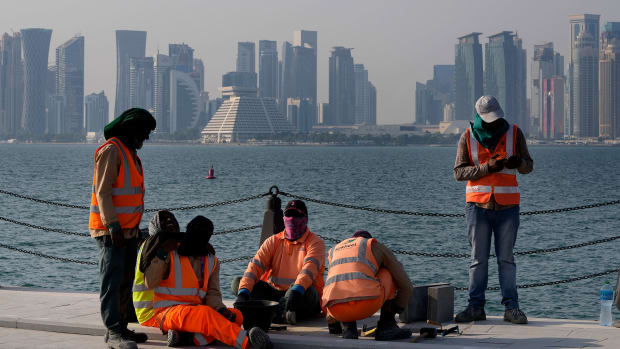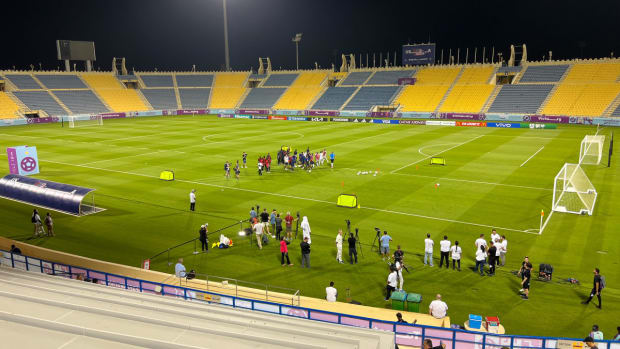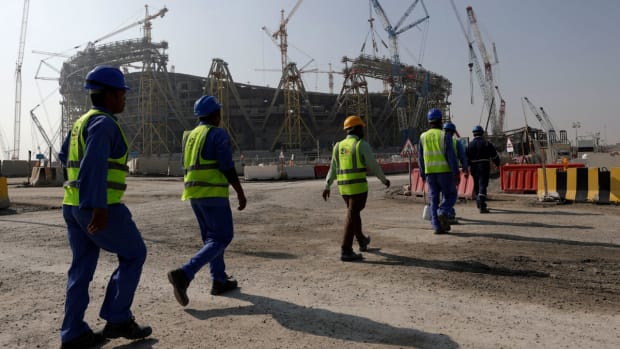DOHA, Qatar – Spend two days traversing a city this sprawling, where there’s a mall with gondola rides, supermarkets that make Costco seem tiny by comparison and 51 square miles that unspool like so much more, and several things become immediately obvious.
There are a lot of stray cats.
There is a lot of money.
And, with the World Cup opener only a few days away, there is construction everywhere, on every block, in every shopping center, even in some of the stadiums. Talk about a deadline.
What stands out most, though, is the juxtaposition. At least so far. This reveals itself in many ways but none more prominent than this: There’s a version of Qatar, the one that government and soccer officials want visitors to see—and there’s Qatar itself, a country that’s complicated and beautiful, clinging to old ways of living and modernizing all at once.
Doha features luxury hotels and plentiful dining options, is app-friendly and generally welcoming—as long as you’re inside the bubbles that have been created. Leave the bubble, and it’s clear that all the stories, documentaries, investigations and laudable work done by journalists and human rights groups over the past 10 years is still relevant, still resonant, still in many, if not all, ways true. It’s the juxtaposition that cannot be escaped, and it’s hanging over this World Cup like a dust storm, engulfing even groups that are trying to do what they can and still play soccer.

Hassan Ammar/AP
On Monday afternoon, aboard Doha Metro’s green line, the passengers represented the juxtaposition. There were local kids headed home from school, expats clocking out after their workday and a few curious types—journalists, fans, officials—who arrived six days before the World Cup began. The station was immaculate and shiny, emitting a new-car smell. Signage announced the tournament, its top players, the stakes.
The train’s cars were outfitted with real seats—full headrests, upholstered backs, polished armrests for tired elbows, the works. The ensemble gave off a 1980s-airline-seat vibe. The train moved quickly and smoothly, and all of that felt like progress, one promise the host country had fulfilled. But then there were the signs inside the train—pictures for no smoking, no eating, no littering, no sleeping and, best I could tell, no holding hands. That led to thoughts, so many thoughts, about the workers who modernized this metro system, about the ones who died and the ones who live with scars from brutal conditions and unfulfilled promises, about why it matters whether people actually, well, hold hands. That’s the juxtaposition here, and it looms over everything, including a nondescript ride on an unexpectedly impressive train.
This train stopped at Al Bidda, the neighborhood in Doha that is home to the Fan Festival that FIFA has set up. The walk from the stop to the festivities took almost 45 minutes, winding through the vast Al Bidda Park. People barbecued their dinners at pits that are set up, and locals played pickup hoops, while elsewhere there were sand pits, climbing frames, even a zip line. There were mazes and gazebos, a display of the Qatar national flag, an amphitheater, a watchtower, a monument—the Arched Monument, think: St. Louis—and even a bridge and a bowling alley. The hoopers wore NBA jerseys—Dennis Rodman, Bulls; LeBron James, Heat and Cavaliers—but otherwise live in a country where they cannot expose their shoulders. No women were playing on the basketball courts, or the tennis courts, or the pickleball courts.
And, upon arrival at the fan festival on the far edge of the grounds, many locals here to see the spectacular were being turned away. Closed. We’re closed. Come back tomorrow, the security guards said. That’s the juxtaposition, the difference between “we created this really elaborate fan festival to help locals and visitors feel at home at the World Cup” and the same thing with “but we’re not ready to show anyone yet; first, it must be perfectly shaped for consumption.”
On some level, this happens all the time, throughout sports and especially at major events. But it’s different here, the contrast more pronounced. Deeper, wide as the Persian Gulf. All along the walk through the park, workers built, painted, polished and applied finishing touches. Some were building a supermarket at midnight local time, with no signs of slowing down. It’s impossible to see Qatar and not see them.
That’s the World Cup so far, and I wonder whether it will change. I doubt it.

Greg Bishop/Sports Illustrated
On Tuesday evening, U.S. Soccer welcomed a group of 20 migrant workers to Al Gharafa SC’s Thani bin Jassim Stadium, the USMNT’s training base, where they watched several American players do drills and got to play with them. Two bright banks of lights illuminated the field as the sun dropped, which tends to happen in the early evening here. Sponsors lined the edge of the pitch, like at any World Cup. But here, some of those sponsors, like Budweiser, stood in direct contrast to Sharia law.
Yellow and red cones had been set up on the field, with three soccer balls laid next to each. They stood near smaller, neon nets and larger, more typical ones. What looked like a control tower loomed above, as did U.S. signage that read “Only Forward,” the team’s motto throughout this World Cup cycle. As many guards as other people filled the stadium. They were friendly, the turf was immaculate and, oddly, the sound of what appeared to be bird calls filled the air. But while this isn’t a new stadium, renovations were still being completed—by migrant workers. They were sanding and polishing floors, putting up more signage and, in the media tribunes, wiping off bird excrement and installing seats. The lucky ones were unionized. But I found myself more drawn to them than the workers on the field.
At 5 p.m., the workers who would play soccer jogged onto the pitch. Immediately, more than a dozen cameras of all types trained on their smiling faces. FIFA officials walked on after them, wearing even larger grins. The workers wore mostly black jerseys, while their “coaches” for the hour donned either blue, black or red. You could tell the difference by their waistline, no color necessary, because the workers’ bodies were trim and slim, with nary an ounce of fat.
They stood in a circle and received instructions. They jogged between cones. They knocked out high-knees and butt-kickers. Through no fault of the workers, the folks who staged this or the U.S. participants, it was a bit uncomfortable, as many things were true at the same time.
This event, titled “Team 360,” is one of a handful that multiple national teams will be hosting and was designed to symbolize the Qatari organizing committee’s “approach to worker’s welfare” and “celebrate the workers’ contributions to the tournament, in a united front with the players.” This isn’t a bad thing, necessarily, especially the part about celebrating their contributions.
The U.S.’s participation came across as the national team trying its best in an impossibly difficult situation, continuing with its “Be the Change” mantra, which was developed by the players after George Floyd’s murder in 2020. Its goal, to have a positive impact on everyone, is what U.S. Soccer intended to bring to the World Cup. Not in a spirit of defiance, but in one of openness and impact. Hence the rainbow crest the national team is displaying in areas it can control. There’s nothing wrong with any of that.
It's impossible, too, to fault the workers on that soccer field, after everything—the lives they’ve led, the sacrifices they’ve made, the friends they’ve lost (as has been widely documented in recent years, thousands have reportedly died building the infrastructure for this World Cup). To see them in a light-hearted environment, for even an hour, taking penalty kicks against professional players, wasn’t insignificant. Their smiles weren’t fake. It’s all fair. But those sentiments must also be placed in the right contexts, from government aims (see how nice we are to migrant workers!) to FIFA aims (let’s get back to soccer!), to consumption aims (hey, look at this backdrop for this story!). None of those matter nearly as much as what has already happened, as what is still happening.

Hassan Ammar/AP
The part I couldn’t reconcile were all the cameras, all the free advertising for folks who want viewers and visitors to see something more palatable, more gleaming, more we-are-the-world than the truth. Those workers still died. Acknowledging that something went very wrong is laudatory. So is trying to help, in whatever possible way.
The U.S. certainly isn’t alone in this regard. Portugal attacking midfielder Bruno Fernandes told Sky Sports, “We've seen the surroundings over the past few weeks and months and about people who have died on the construction of the stadiums. We are not happy for that.” He was doing what he could.
Christian Eriksen, whose Denmark side had a request to train in shirts that read “Human Rights for All” denied by FIFA, agreed with his Manchester United teammate. Also speaking to Sky, he said about the World Cup, “It hasn’t gone the right way. … We try to say our thing and do what we can. We want to get focused on it, but the change has to come from somewhere else.” Also doing what he could.
The Dutch national team also has plans to meet with workers after a training session, as part of the KNVB’s (the soccer federation) push to promote human rights. Going a step further, the KNVB announced plans to auction game-worn World Cup shirts, with the proceeds going to those workers.
“It has not escaped anyone’s notice that facilitating the tournament has had a huge impact on migrant workers in Qatar,” captain Virgil van Dijk said. “They have worked on stadiums, infrastructure and hotel accommodation under very harsh conditions. We will remember that during all our activities there. It is clear to everyone that those conditions really need to improve.”
“We hope that our presence will contribute to the changes currently underway.”
But coach Louis van Gaal also admitted in a news conference that events like this must be contrived. How else would the workers and the players cross paths? But, he added, “The fact we want to do it says something about the thoughts of the KNVB, and that’s what it’s about.” There it is again. Doing what they can.
Regardless of how the next few weeks unfold, whether improvements via unions for workers in Qatar are real or more intentional distractions, nothing will change the juxtaposition. Or at least it feels that way. The U.S. players did what they could Tuesday, the intentions all good. There were pictures snapped and memories made, along with statements of inclusion. But as everyone exited Thani bin Jassim Stadium, one sign was too rich to miss.
“CELEBRATE,” it read, in large white script.
The question is: Celebrate what? Moments like this? The tournament itself? Small assists to migrant workers? A star-studded FIFA Fan Festival opening, scheduled for Saturday, the day before the opener? I’d buy anything, really, that acknowledges this juxtaposition, that it exists and has existed and should exist until real and lasting change is made. Because the legacy of this World Cup shouldn’t be what Qatar wants to reveal about itself. It should be what Qatar actually is.







